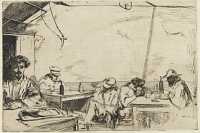Etchings Institutions search term: wunderlich
Soupe à trois sous | ||
| Number: | 64 | |
| Date: | 1859 | |
| Medium: | etching | |
| Size: | 152 x 228 mm | |
| Signed: | 'Whistler. -' at upper right | |
| Inscribed: | no | |
| Set/Publication: | no | |
| No. of States: | 1 | |
| Known impressions: | 56 | |
| Catalogues: | K.49; M.49; T.25; W.27 | |
| Impressions taken from this plate (56) | ||
KEYWORD
TITLE
'Café des Pieds Monilles' (1874, Whistler). 2
'Soup à Trois Sous' (sic) (1874, James Anderson Rose (1819-1890)). 3
'Matrosenkneipe' [sailor's pub] (1881, Berlin). 4
'Soupe à trois sous' (1886, Frederick Wedmore (1844-1921)). 5
'La Soupe à Trois Sous' (1905, Paris). 6
Whistler's first title, 'Café des Pieds Monilles' implies a particular café. 'Café des Pieds Monilles' is almost certainly a garbled reference to the Parisian Café des Pieds-Humides ('Café of the Wet Feet'). However, this title seems to have been immediately rejected in favour of the more familiar 'Soupe à trois sous'.
'Soupe à trois sous' is French for 'Soup for three sous', which was very cheap soup, and implies that the restaurant was a very basic café/bar.
2: London Pall Mall 1874 (cat. no. 28).
3: Liverpool 1874 (cat. no. 517).
4: Berlin 1881 (cat. no. 712).
5: Wedmore 1886 A (cat. no. 27).
6: Paris Mem. 1905 (cat. no. 303).
DESCRIPTION
SITTER
The Pennells, writing in 1908, interpreted the scene differently: 'Soupe à Trois Sous was done in a cabaret kept by Henri Martin, whose portrait is in the print and who was famous in the Quartier for having won the Cross of the Legion of Honour by his bravery at an earlier age than any man ever decorated, and then promptly losing it by some shameful deed.' 8 Later, in the Whistler Journal, the Pennells, having consulted Théodore Duret (1838-1927), added:
7: 'Mr Whistler's Paintings', Baltimore Gazette, after 1 April 1876, in GUL PC1/75; partially quoting E.D. Wallace, 'The Fine Arts Abroad', Forney's Weekly Press, Philadelphia, 1 April 1876.
8: Pennell 1908 , I, p. 70.
9: Pennell 1921C , pp. 91-92.
SITE
It is not, apparently, to be confused with the Café des Pieds-Humides on the Rue de Courcelles, 'the very sign-board of which makes one shudder'! 11
10: Auguste Lepage, Les Cafés artistiques et littéraires de Paris, Paris, 1882, p. 289-90.
11: Albert D. Vandam, French Men and French Manners, London, 1895, p. 274.
DISCUSSION
12: Lochnan 1984 , p. 102.
